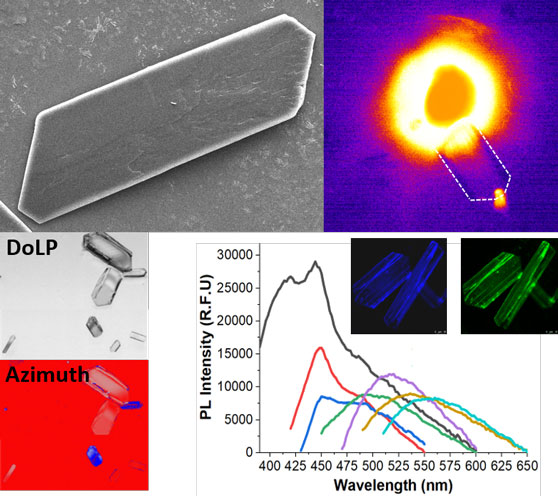More:
News & Stories
New Discovery: ‘Lighting the way’ for new implantable medical devices
Multidisciplinary research conducted jointly in 2 HIT faculties, Engineering and Science, reveals that microstructures made of amino acids can be used as multifunctional bio-photonic devices and neuronal optical switches which provide new clinical possibilities for identifying and treating disease The study also provides novel approaches in signal processing to create effective micro-chips.

A joint study by HIT researchers Dr. Amir Handelman from the Faculty of Engineering, Dr. Igor Lapsker and Dr. Alexander Laikhtman from the Faculty of Science (HIT) and Dr. Avi Yaakov from Bar-Ilan University, showed that microcrystals made up of the amino acid histidine can be applied to produce various photonic devices photonic devices which can be used in medical devices, in-body sensors, and electronic chips.
Histidine is one of the 20 natural and essential amino acids produced in the human body, which is consumed through foods such as grains or animals. It has many biological functions in human growth, metal transmission, neurotransmission, and neuro-modulation. An abnormal level of histidine or histidine-rich proteins is often considered as an indicator of many diseases. High levels of histidine/histidine-rich proteins, for instance, have been associated with certain metabolic disorders, malaria, and thrombotic diseases. low levels have been linked with rheumatoid arthritis, epilepsy, chronic kidney disease, and advanced liver cirrhosis.
Using an electronic microscope, Dr. Handelman and colleagues discovered new undiscovered microstructures made of the amino acid histidine. Moreover, they found that when the microstructures are heated to about 180 degrees celsius, they emit blue, green or red fluorescent light (depending on the wavelength of the excitation light). Theoretical calculations and laboratory experiments were carried out by the researchers to analyze the optical response of these microstructures when illuminated by linear polarized light. This also demonstrated how these microstructures can become waveguides in visible light.
Dr. Alexander Laikhtman, Deputy-Dean of the Faculty of Science and Head of the Materials Research Laboratory, attributes the success of the experiment to the state-of-the-art equipment made available to researchers at HIT: “The advanced and diverse scientific equipment in the Faculty of Science laboratories, combined with the highly experienced laboratory staff, facilitates multidisciplinary research into advanced materials. The Micro-Raman system installed about a year-and-a-half ago provided important information about the chemical and crystalline structure of the amino acid histidine and the stability or changes of amino acid molecules after various treatments. The AFM atomic power microscope shows a three-dimensional image of the amino acid crystals in an air environment, while using the two SEM electron microscope scanners, we were able to measure the morphology of the crystals in their various shapes and in high resolution, as well as their chemical composition”.
Dr. Handelman, the lead researcher in the study, concluded: “We demonstrated in the study that microcrystals made of the amino acid histidine can serve as diverse photonic devices, such as light sources, polarizers and waveguides. In this way, these structures can even be used as ‘on-off key switches’. We have demonstrated that in addition to the known biological functions of the amino acid histidine - its various properties can be applied to different optical devices which can meet a broad range of medical needs in the human body”.
Possible uses of the discovery are in the field of opto-genetics (a biological technique that uses light) for the purpose of stimulating or silencing the function of specific nerve cells (neurons), and achieving an accurate understanding of brain function and the function of specific neurons. The electronics industry can also utilize this discovery to developing innovative optical chips.
The study was published in the scientific journal Advanced Functional Materials. One of the most prestigious in the field of engineering and materials science, the AFM has an exceptionally high journal-impact factor (IF = 16.8) which publishes based on the merits of the individual articles and researchers. Highly selective in its acceptance practices, less than 25% of articles submitted to the journal are published.
The full article is available online:
https://onlinelibrary.wiley.com/doi/10.1002/adfm.202008183
The research was funded through a research grant from the Ministry of Science and Technology (which also includes Dr. Boris Apter from the Faculty of Engineering, Prof. Boris Feinberg from the Faculty of Science, as well as Prof. Gil Rosenman and Prof. Pavel Ginzburg from Tel Aviv University).
Posted: 30/12/2020
- News & Events
International Week of Interdisciplinary Studies and Academic Collaborations in Crete
A substantial delegation of 16 students and four faculty members from HIT Holon Institute of Technology participated in week-long international activities and events at HMU-Hellenic Mediterranean University in Crete. ...


 Additional programs
Additional programs
